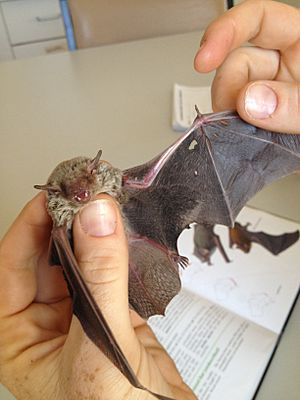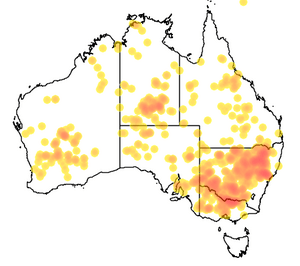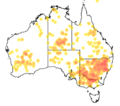Western broad-nosed bat facts for kids
Quick facts for kids Western broad-nosed bat |
|
|---|---|
 |
|
| A broad-nosed bat being held with its wing spread out. This one was found inside a house in South Australia. | |
| Conservation status | |
| Scientific classification | |
| Genus: |
Scotorepens
|
| Species: |
balstoni
|
 |
|
| Map showing where inland broad-nosed bats have been seen. | |
The western or inland broad-nosed bat (Scotorepens balstoni) is a type of vespertilionid bat. These bats live only in Australia and are found all over the inland parts of the country. They especially like dry and semi-dry areas. This small bat eats insects and is about 12 cm long. During the day, it sleeps in tree hollows. At night, it flies over woodlands and water to find food.
Contents
What Does the Inland Broad-Nosed Bat Look Like?
The inland broad-nosed bat is a medium-sized microbat. It has a special broad, square-shaped nose when you look at it from above. This shape comes from swollen, bumpy pads on its face.
Its fur can be dark brown or even a pale sand color. Most often, its back is light grey-brown, and its belly is pale brown. Like other broad-nosed bats, it has short, thin ears and small eyes. Its tail is completely inside a membrane called the uropatagium. It also has only one upper front tooth on each side.
To tell this bat apart from others, scientists often measure its forearm length and look at where it lives. Its short tragus (a small flap in the ear) is about 4 mm long, which also helps identify it. Male bats are usually a little smaller than females.
Bat Measurements
Here are some average measurements for the inland broad-nosed bat:
| Weight | Forearm length | Ear length | Tail length | Wingspan | |
|---|---|---|---|---|---|
| Average | 9.3 g | 36 mm | 13 mm | 36 mm | 278 mm |
| Range | 6-14 g | 32–41 mm | 11–14 mm | 29–42 mm | 252–295 mm |
These bats use echolocation to find their way and hunt. They make high-pitched sounds that bounce off objects. In Western Australia, their echolocation sounds are usually between 34.1 and 38.7 kHz. In New South Wales, they are between 28 and 34 kHz.
Where Do Inland Broad-Nosed Bats Live?
Inland broad-nosed bats live across much of inland Australia. This includes very dry (arid) and partly dry (semi-arid) areas. You generally won't find them east of the Great Dividing Range.
Preferred Habitats
In Western Australia, they live in areas like the northern wheatbelt and the Murchison region. They prefer woodlands with Mulga trees, but also live in Salmon Gum and York Gum woodlands.
In the semi-dry Mallee region of Victoria, these bats like open woodlands and dryland woodlands. They have also been seen in places like Willandra Lakes in New South Wales and Dangalli in South Australia. In South Australia's dry areas, they often live near River Red Gums along rivers and streams.
Bat Behavior
Roosting Habits
Inland broad-nosed bats like to sleep in tree hollows during the day. They often gather in groups of up to 45 bats. They also roost in the roofs of buildings, under metal caps on power poles, and inside water pipes. These bats often hang horizontally when they sleep. Sometimes, they even share their roosts with other bat species, like the south-eastern freetail bat.
Diet and Foraging
These bats are excellent insect hunters in the air. In northern Australia, they eat cockroaches, termites, crickets, cicadas, bugs, beetles, flies, moths, and ants. In Victoria, their diet mainly includes beetles, ants, bugs, moths, flies, and grasshoppers.
They start hunting earlier than most other bats, usually right at dusk. They use echolocation while flying to find their prey. They stay within 15 meters of the ground and make quick turns to catch insects. They mostly hunt between trees, not flying above the treetops. They also venture into open areas at the edges of forests. These bats can fly at speeds between 12 and 21 km/h. Their smooth head, silky fur, and small, specially shaped ears help them fly very efficiently.
Reproduction and Life Cycle
In the southern parts of Australia, these bats usually mate around April or May. The mothers then give birth to one or two babies in mid-November. In the northern areas, mating happens in September, and they often have twins, though sometimes triplets are born.
Newborn bats are born without fur and are quite developed. They have special curved milk teeth that help them hold onto their mother. When the babies are about 12 days old, their milk teeth are replaced by their permanent adult teeth. They stay attached to their mother until they are about 10 days old. At this point, they weigh around 4 grams. After this, the mother leaves them behind in the roost when she goes out to hunt at night.
Their eyes open and fur starts to grow when they are about 15 days old. By 30 days old, they begin to practice flying their wings. Soon after, they start to hunt for food on their own.
How Bats Adapt to Dry Areas
Inland broad-nosed bats have special ways to live in dry and semi-dry areas. In very dry places, they seem to hunt for food close to water sources and their roosting spots. They might get most of their water from the insects they eat. They also save water by making very concentrated urine, thanks to special kidneys.
In semi-dry areas, they hunt near water and drink while flying. Like other animals in dry zones, these bats can likely go into a deep sleep called torpor for long periods. This helps them save energy and water, especially in southern areas. Another way they adapt to dry and hot places is by being able to handle high body temperatures.
Conservation Status
Even though inland broad-nosed bats are common, their numbers are slowly going down. Because they are found in many places, have a large population, and live in protected areas, they are listed as "least concern" on the IUCN Red List. This means they are not currently in danger of disappearing.
However, more research is needed to find out exactly what threatens this species. Some likely threats to their roosting and feeding areas include farming, logging, and clearing land for houses. Changes in fire patterns that destroy trees with hollows, and blocking access to their roosting sites, are also concerns.
It's important for researchers or wildlife rescuers to know that these bats can be aggressive. Their strong jaws can deliver a painful bite. Because of their aggressive nature, it's a good idea to keep them separate from other bat species if you are handling them.
Images for kids




